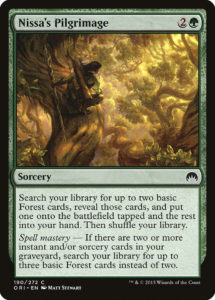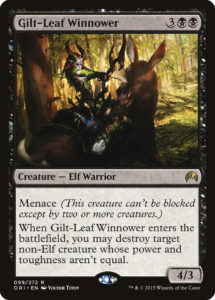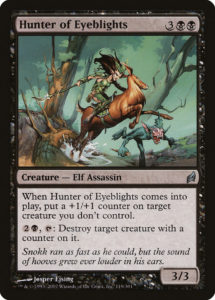In honor of Mark Rosewater’s podcast focusing on Lorwyn, today let’s focus one of my favorite card designs ever: Magic Origins’ Gilt-Leaf Winnower. After all, there’s a wealth of card designs in Magic’s twenty-six year run and some of us have been jamming Ravnica Allegiance non-stop in preparation for MagicFest Cleveland.
Setting the Stage
Gilt-Leaf Winnower was created in 2015’s Magic Origins, the second set of the Two Block Paradigm and the last Core Set until 2018. Origins was likely the most ambitious Core Set ever, as it told the origin stories of the five Planeswalkers who would form the Gatewatch and was spread over an unprecedented ten planes. Origins had to not only introduce brand new worlds like Vryn and Kaladesh and tell five separate stories (each across two planes), it also had to substantially change the character of Nissa Revane.
Nissa hails from Zendikar and was introduced in its titular set. I’m not terribly familiar with the source material, but Nissa Revane is clearly an Elf-focused planeswalker; and everything I’ve heard about In the Teeth of Akoum suggests she was a fervent racist and fairly unlikable character. She wasn’t exactly prime character material, but with Garruk Wildspeaker cursed and insane, she was the best available choice as the Green representative of the Gatewatch. Accordingly, Magic Origins gave her new, more likable persona and less tribal-constrained mechanics. (You can read all about this in Levi’s two-part series.)
Magic Origins introduced a young Animist focused on lands rather than elves. Her first planeswalk to Lorwyn introduced her the plane’s unlikable, racist Elves who demonstrated that neither trait is desirable. She met Dwynen, Gilt-Leaf Daen and watched her slaughter a band of Goblins in Eyeblight Massacre simply for failing to meet the elvish standard of beauty (which seems to mostly only include Elves). This is the defining moment that prevents Nissa from becoming Nissa Revane.
That is the story told on today’s card, but without any need for explanatory flavor text.
The Man with the Moonglove
Take a moment and look at this card. Look at its abilities, its cost, and its numbers.
Yes, this is a very powerful card in Limited. It’s comparable to Nekrataal in that it can’t kill everything, but it’s a solid two-for-one and has a strong ability (which was only keyworded in this set despite having been introduced 21 years earlier in Fallen Empires). But there’s more here.
Have you ever seen the concept of hypocrisy so cleanly and clearly communicated on a card? This elf is a Hunter of Eyeblights—it makes clear that squared stats are aesthetically pleasing and creatures with unequal power and toughness are eyeblights. But not only can elves not arouse its ire, but Gilt-Leaf Winnower is an eyeblight by its own definition. Aah, I love this little bit of design. It tells you just how awful the elves of Lorwyn are, and it does it through solid design.
Precedent
We’ve talked quite a bit about how the elves of Lorwn hunt and kill eyeblights. This concept appeared in the original Lorwyn as well. But Hunter of Eyeblights is a very different take on the concept than Gilt-Leaf Winnower. Whereas the Winnower is a clear, cold executioner of non-elves; Hunter of Eyeblights is about the hunt, telling a story akin to The Most Dangerous Game. It nurtures its quarry, giving it a head start before going in for the kill.
There’s a strong story here—if the Hunter fails in its mission, then the quarry is now more even more dangerous. But whereas Hunter of Eyeblights tells a cool story about a hunt on Lorwyn, Gilt-Leaf Winnower tells us about the brutal, hypocritical nature of Lorwyn’s elves.
I love that these two cards execute on the same concept so differently. While I appreciate the design of Gilt-Leaf Winnower more, I recognize that its design likely went in this direction because Hunter of Eyeblights had already blazed a different trail. I can think of many cards that communicate cool, individual, resonant stories like the Hunter, but I can think of very few cards that evoke a concept the way that the Winnower evokes hypocrisy.
As game designers and players, there’s a lot we can learn here. Not everyone is going to geek out about these mini-stories and bread crumbs we scatter, but some people are going to respond to them very strongly. The more crumbs one scatters to the more audiences one’s game caters to, the more people might emotionally connect with the game. It’s also good to consider what kind of breadcrumbs you most respond to.
And that’s all I’ve got to say about Gilt-Leaf Winnower. This week, I fly to Cleveland to cheer on Richard Tan at the Pro Tour and play some Ravnica Allegiance Limited at the Grand Prix. Here’s hoping it’s a blast. And, as always, thanks for reading.
—Zachary Barash is a New York City-based game designer and the commissioner of Team Draft League. He designs for Kingdom Death: Monster, has a Game Design MFA from the NYU Game Center, and does freelance game design. When the stars align, he streams Magic.
His favorite card of the month is Coat With Venom. It does a whole lot for a single mana and heralded the design of many more flexible combat tricks. Plus, it’s a solid combat trick that neither cantrips nor provides a massive power buff, which is hard to do.




